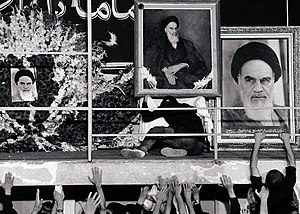
Back وفاة وجنازة روح الله الخميني Arabic مرگ و تشییع سید روحالله خمینی Persian Funerali di Ruhollah Khomeyni Italian
 Mourning men in residency of Khomeini around his seat area, Jamaran. | |
| Date | 5–6 June 1989 |
|---|---|
| Location | Musalla, Tehran, Iran (Public viewing) Behesht-e Zahra cemetery (Burial) |
| Participants | Iranian officials and clerics, relatives and millions of followers. |
| Deaths | 8 due to a stampede |
On 3 June 1989, at 22:20 IRST, Grand Ayatollah Ruhollah Khomeini, leader of the Iranian Revolution and the first Supreme Leader and founder of the Islamic Republic of Iran, died in Jamaran, Greater Tehran aged 89 after spending eleven days at a private hospital, near his residency, after suffering five heart attacks in ten days.[1][2] Sources put his age at 89, and list the cause of death as bleeding in the digestive system.[3] As a mark of respect, Iran's government ordered all schools to be closed on Sunday and declared 40 days of mourning and said schools would be closed for five days.[4][5] Pakistan declared ten days of national mourning,[6] Syria announced seven days of mourning,[6] Afghanistan, Lebanon and India announced three days of mourning.[6][7]
Khomeini was given a state funeral and buried at the Behesht-e Zahra (The Paradise of Zahra) cemetery in south Tehran.[8] It was estimated that around 10 million people participated in his funeral, one-sixth of the population of Iran, which is the largest proportion of a population ever to attend a funeral procession and also one of the largest gatherings in human history.[9][10]
- ^ Buchan, James (12 March 2009). "Ayatollah Khomeini's funeral: The funeral of Ayatollah Khomeini was not a tragedy but a gruesome farce". New Statesman. Retrieved 12 November 2018.
- ^ "Khomeini Had 5 Heart Attacks". Sarasota Herald-Tribune. 13 June 1989. Retrieved 12 November 2018 – via Google News.
- ^ "Khomeini, Imam of Iran And Foe of U.S., Is Dead". The New York Times. 4 June 1989. Retrieved 12 November 2018.
- ^ Moseley, Ray; Reaves, Joseph A. (June 7, 1989). "Mourners Rip Shroud, Khomeini's Body Falls". Chicago Tribune. Retrieved September 6, 2022.
- ^ Joseph, Ralph (June 4, 1989). "Khomeini dead". UPI. Retrieved September 6, 2022.
- ^ a b c "Death of the Ayatollah : Islamic Nations Mourning; Bhutto Hails Leadership". Los Angeles Times. 5 June 1989. Retrieved September 6, 2022.
- ^ Luddington, Nick (June 5, 1989). "Iraq, Isreal (sic) Call for Closer Ties with Iran; US Wants Hostages Freed with PM-Iran-Khomeini". Associated Press. Retrieved September 6, 2022.
- ^ Gölz, Olmo (2019). "Die Drohung der ungewissen Zukunft: Der Tod Nassers und Khomeinis als Epochenbruch.". In Cornelia Brink; Nicole Falkenhayner; Ralf von den Hoff (eds.). Helden müssen sterben: Von Sinn und Fragwürdigkeit des heroischen Todes ["The Threat of an Uncertain Future: The Deaths of Nasser and Khomeini as an Epoch Break." In: Heroes must die: Of the meaning and dubiousness of heroic death] (in German). Baden-Baden: Ergon. pp. 231–45. Retrieved 20 May 2024.
- ^ Pendle, George (2018-08-29). "Which Famous Figure Had the Biggest Public Funeral?". HISTORY. Archived from the original on 2021-10-30. Retrieved 2021-12-25.
- ^ Philipson, Alice (January 19, 2015). "The ten largest gatherings in human history". The Telegraph. Archived from the original on October 29, 2021. Retrieved December 25, 2021.
© MMXXIII Rich X Search. We shall prevail. All rights reserved. Rich X Search